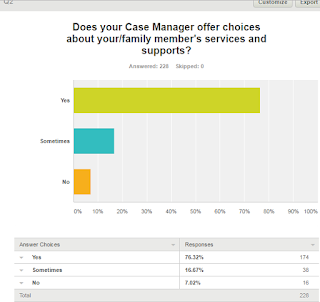The CDHS Division for Regional Center Operations (DRCO) oversees the three state-owned and -operated Regional Centers in Grand Junction, Pueblo, and Wheat Ridge. The Regional Centers serve people with intellectual and developmental disabilities (I/DD) who have intensive needs. Currently the Regional Centers have 200+ residents in the long-term habilitation model.
 In all practical ways, the Regional Centers are not the institutions we knew years ago. They are Colorado owned and operated homes that are either cost reimbursed ICF-IDD models or HCBS-DD Waiver super funded homes, much the same as privately operated ICF-IDD homes and privately operated HCBS-DD Waiver funded homes (without the super).
In all practical ways, the Regional Centers are not the institutions we knew years ago. They are Colorado owned and operated homes that are either cost reimbursed ICF-IDD models or HCBS-DD Waiver super funded homes, much the same as privately operated ICF-IDD homes and privately operated HCBS-DD Waiver funded homes (without the super).Where does the word super fit in?
Well, for years the Colorado Legislature, at the request of the Colorado Departments, has super funded the State operated homes to keep up with the cost of doing business. It is important to understand that whether or not the State operated homes represent the provider of last resort, Colorado has no other option other than outsourcing this very important service to private providers within Colorado or other states.
Why doesn’t Colorado outsource? It simply cannot afford to do so today.
 Do the Regional Centers have a place in our future service model? I don’t believe there is anyone in our system – not the individuals we serve, not families, not providers, not the people running the Regional Centers, and not our rule makers - who doesn’t believe that healthy communities are inclusive communities, and that individuals with I/DD should have every opportunity to be active, participating members of their communities.
Do the Regional Centers have a place in our future service model? I don’t believe there is anyone in our system – not the individuals we serve, not families, not providers, not the people running the Regional Centers, and not our rule makers - who doesn’t believe that healthy communities are inclusive communities, and that individuals with I/DD should have every opportunity to be active, participating members of their communities.And yet, because of where our focus is, decisions are being made that would seem to indicate that we haven’t learned our lessons and we will continue to use super-funded State operated homes as our preferred State business model.
Want proof? Here’s some startling evidence:
- In Fiscal Year (FY) 2015 – 16, Colorado’s expenditures at the Regional Centers was $35,213,622.
- In November of 2016, CDHS initiated wage increases for the Regional Center staff raging from a low of 20.6% increase to a high of 51.5% increase. The annual cost of this wage increase for FY 2017 – 18 is $8,757,198. This adjustment is reflected in the Colorado’s budget for FY 2017 -18, and translates to a 24.8% increase in funding over two years. Why? Because this is what it costs!
- Meanwhile, the Colorado’s Joint Budget Committee authorized no community provider rate increase for FY 2017 and only a 1.4% increase in rates for community providers of the same service as Regional Centers for FY 2018.
- As the CDHS website indicates above, the Regional Centers serve 200+ (let’s call it 250) individuals each year. Over the next two years, they will be receiving $8.7 million increase to address the true cost of doing business. That translates to resources of about $175,000 annually for each of the 250 people receiving services in a regional center home.
- On the other hand, Colorado’s community providers serve about 10,500 people, but will only be receiving a rate increase of about $5.8 million over the next two years … FOR 10,500 PEOPLE! That translates to annual resources for individuals in the Comprehensive Services Waiver of about $70,000 per person.
 Those stats tell me one thing: The Colorado Business Model for people who have an I/DD is suggesting to parents and guardians - if you want to more than double the resources available to your son or daughter, sign up for a State operated home. It is the State’s preferred model. The employees serving your son or daughter are well compensated.
Those stats tell me one thing: The Colorado Business Model for people who have an I/DD is suggesting to parents and guardians - if you want to more than double the resources available to your son or daughter, sign up for a State operated home. It is the State’s preferred model. The employees serving your son or daughter are well compensated.I wonder if those leading this charge are even aware of the message that is being sent by their decision making.
And guess what? There is much more to this story. Tune in next time and we will examine what is around the corner.
Then again, what do I know?

























